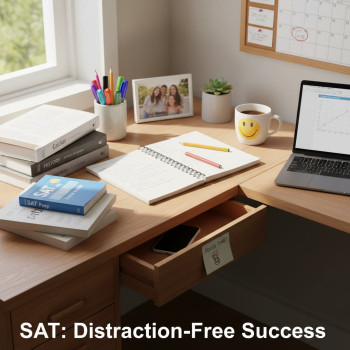Why this matters: calculators on every Digital SAT math question
If you’re preparing for the Digital SAT, you’ve probably heard a lot about the built-in calculator and the option to use your own non-CAS calculator. Unlike the old paper SAT with calculator and no-calculator sections, the digital format treats the calculator as a universal tool for the entire Math section. That’s a big shift—and an opportunity.
This article explains exactly why the Digital SAT allows calculator use on every math question, what that change means for your test-day strategy, and how to turn the calculator from a crutch into an advantage. I’ll walk you through practical tips, sample approaches, and a simple study plan you can adapt. I’ll also mention how Sparkl’s personalized tutoring can slot into your prep—if you want focused, tailored help to practice calculator strategies, short targeted sessions with expert tutors can accelerate your progress.
The short answer: equity, realism, and the digital toolkit
At its core, the decision to let students use a calculator for every math question reflects three straightforward goals:
- Equity: Digital testing means every student sees a slightly different adaptive form of the test. Standardizing the availability of a calculator keeps the testing conditions fair. If calculators were allowed only on some items, differences in how students encounter those items would create inconsistencies.
- Real-world relevance: The math on the SAT favors problem-solving, modeling, and algebraic thinking—the same kinds of tasks people do in real life where a calculator is a normal tool. Allowing calculators aligns the test with how math is used beyond school.
- Digital tools integration: The Bluebook testing environment includes a built-in Desmos calculator and other universal tools (reference sheets, highlights, line readers). Since the digital platform provides these aids uniformly, permitting calculator use for all math items fits the test’s digital design.
But wait—does that mean you should use a calculator all the time?
Not necessarily. A calculator is powerful, but it can slow you down or hide mistakes if you use it reflexively. Smart test-takers choose whether to use it, when to rely on mental math, and when to combine both approaches. The test designers know calculators are available, so question design focuses on reasoning and strategy rather than raw computation. Think of the calculator as an instrument in your toolkit—use it where it adds value, not where it creates more steps.
When to skip the calculator
- Simple arithmetic that you can do faster in your head or on scratch paper.
- Problems where an algebraic manipulation or insight removes the need for numbers (for example, factoring or noticing symmetry).
- Questions that are structured to punish over-reliance on numeric blundering (e.g., when intermediate rounding leads you astray).
When the calculator is your friend
- Complex multi-step arithmetic where manual work increases careless error risk.
- Graphing problems or curve analysis where Desmos can visualize relationships quickly.
- Data analysis tasks involving statistics, large numbers, or percent changes across several steps.
How the digital format changes strategy (and why that matters)
Two interrelated features of the Digital SAT change how you approach the math section:
- Adaptivity and modules: The test is delivered in modules, and items are selected so difficulty adapts as you progress. That changes pacing and question selection strategy.
- Universal tools: The built-in calculator, reference sheet, and highlighting tools are consistently available, so your strategy can take them into account every time.
Because the calculator is available for all math items, you can plan ahead with a reliable workflow: quick mental screening, deliberate calculator use for heavy arithmetic, and a habit of double-checking critical steps. That workflow reduces wasted time and helps avoid simple but expensive mistakes.
Pacing with a calculator in play
Many students believe using a calculator slows them down. A better way to think about pacing is to triage each question in 5–10 seconds:
- Is the answer obvious mentally or by inspection? (If yes, do it mentally.)
- Would a quick algebraic simplification remove the need for numbers? (Try it.)
- If numbers are needed, is this a one-step calculation or multi-step computation that benefits from a calculator? (Use the calculator for the latter.)
This decision-tree prevents you from spending eight minutes tediously calculating something you could have simplified in thirty seconds without a calculator.
Concrete calculator strategies that high scorers use
Below are techniques you can practice so the calculator helps rather than hurts.
1. Do a mental estimate before punching numbers
Estimate the magnitude and rough value. If the final calculator answer is wildly different from your estimate, pause and re-check the entry. Estimation is a quick error-catcher.
2. Keep your work organized
Write down intermediate expressions and label them. When you switch between mental work and the calculator, clear notation prevents transcription errors (a common source of wrong answers).
3. Use Desmos for graph intuition
When the question involves roots, intersection points, or the behavior of a function, plotting it in Desmos (the embedded graphing option) is faster and less error-prone than algebraic guessing. You don’t need a polished graph—just enough to see where curves cross or how slopes behave.
4. Cross-check with a different approach
If time permits, compute the result in two ways: algebraically and numerically. If both agree, your confidence rises. If not, you’ve caught an error early.
5. Memorize calculator-friendly shortcuts
Learn keyboard or button sequences that reduce clicks. Practice the Desmos tools (toggle between scientific and graphing modes, use parentheses properly, recall statistical functions) so they feel automatic under pressure.
Example walkthroughs: thinking vs. punching
Let’s compare two approaches to the same problem so you can see when the calculator helps.
Problem
“A recipe calls for 3/8 of a cup of sugar per batch. If you need to make 15 batches, how many cups of sugar are required?”
Approach A: Mental and paper-first
Think: 15 × 3/8 = (15×3)/8 = 45/8 = 5 5/8 cups. Convert decimal if needed: 5.625 cups. Fast, few keystrokes, low error risk.
Approach B: Calculator-first
Punch: 15 × 0.375 = 5.625. Correct, but beware of entering 0.0375 by mistake or misplacing a decimal. If you had estimated first (about 5½ cups), the calculator output will confirm the result quickly.
Key takeaway: the calculator is efficient, but estimation reduces the chance of data-entry mistakes and gives you a sanity check.
Practice plan: make the calculator part of your muscle memory
Practice beats theory. Use this four-week focused routine to become fluent with calculator use in test conditions. Adapt the weeks based on your timeline.
| Week | Focus | Daily Task | Goal |
|---|---|---|---|
| 1 | Familiarize with Desmos & device | 20–30 minutes: explore graphing and scientific modes on Bluebook/Desmos | Know button sequences and graphing basics |
| 2 | Speed with simple computations | 30–45 minutes: timed drills—estimate, then calculate; compare | Reduce input errors and improve speed |
| 3 | Multi-step problems & cross-checks | 45–60 minutes: practice multi-step data analysis and graph interpretation | Build reliable two-method checks |
| 4 | Full practice tests in digital format | 1 full module or full test once or twice; review errors | Pacing, stamina, and consistent calculator workflow |
Working with a good mentor speeds this progress. Sparkl’s personalized tutoring focuses on the weak spots students identify during practice—one-on-one guidance can tailor these weeks, compressing months of progress into weeks through targeted correction and practice drills.
Common mistakes students make with calculators (and how to avoid them)
- Blind trust: Entering numbers without estimating. Avoid by taking a two-second guess before calculating.
- Poor notation: Copying intermediate results inaccurately. Keep neat scratch work and label steps.
- Overuse on conceptual items: Using the calculator for questions better solved algebraically. Pause and ask: does algebra make this easier?
- Relying on one tool: Some students only memorize Desmos steps but can’t do quick mental checks. Practice both mental math and the calculator in tandem.
How colleges and scholarship programs view calculator use
Colleges are interested in your reasoning skills more than whether you used a calculator on a given problem. The Digital SAT is designed so calculator availability doesn’t reduce the test’s ability to measure mathematical thinking. Admissions readers want to see evidence that you can reason, model, and interpret data—skills the test assesses regardless of whether a calculator was used.
Accessibility and accommodations: calculators as universal tools
The digital testing environment includes universal tools like the calculator, line reader, and reference sheet so students with varied needs can access the same content. Accommodations further tailor the experience where necessary. In short, allowing calculators on every math question supports equitable access without changing what the test measures: your math reasoning and problem-solving ability.
Quick checklist for test day: calculator edition
- Practice with the same calculator you’ll use on test day (or master Desmos).
- Do quick estimates first—this is your best defense against input errors.
- Write down intermediate expressions and label them.
- Use Desmos for graphs, but avoid over-plotting—look for the insight quickly.
- If a calculation is long, consider whether algebraic simplification can shorten it.
- Be familiar with the calculator rules: no CAS, remove forbidden programs, and silence sounds.
How to practice intelligently (not endlessly)
Quality practice beats quantity. Focused sessions that mirror test conditions—timed modules, Bluebook practice, and mixed-item sets—produce better results than hours of unfocused drills. Make a short list of the mistakes you make most often during practice and target them specifically for two weeks. For example, if you mis-enter decimals, practice decimal entry with a stopwatch until your error rate drops.
For students who want an efficient training partner, Sparkl’s personalized tutoring offers targeted sessions on calculator fluency, pacing, and the exact habits that generate mistakes for each student. Short, regular check-ins with an expert can help build consistent routines, provide accountability, and introduce custom practice sets that reflect your learning gaps.
Final thought: the calculator levels the playing field—use it wisely
The calculator-on-every-question rule for the Digital SAT removes an artificial barrier and better reflects how math is used in the real world. That’s good news. But the test still rewards thinking, not just computation. Your challenge is to build a reliable workflow that blends mental math, clean scratch work, and smart calculator use.
Practice deliberately, learn the Desmos or handheld shortcuts that fit your style, and triage questions quickly. If you want to fast-track that process, consider focused one-on-one help—such as Sparkl’s tutoring—that zeroes in on your specific weaknesses and gives you techniques you can apply immediately. With the right preparation, the calculator becomes less of a novelty and more of a performance enhancer: a steady, predictable tool that lets your reasoning shine.
Want a quick starter plan?
Try this: one week to learn your calculator, two weeks of mixed timed practice (with estimation checks), and a final week of full digital practice tests. Adjust the length based on your schedule, and keep a journal of the three most common errors you make each practice session—then eliminate them, one by one.
Good luck—and study smart
The Digital SAT’s calculator policy is an invitation: practice with purpose, and use the calculator to showcase your reasoning, not to hide from it. With calm preparation and the right strategies, you’ll walk into the testing room confident that your tools—and your thinking—are ready. If you want guided practice tailored to your strengths and weaknesses, Sparkl’s personalized tutors can help you focus your prep and build the routines that consistently lead to higher scores.














No Comments
Leave a comment Cancel